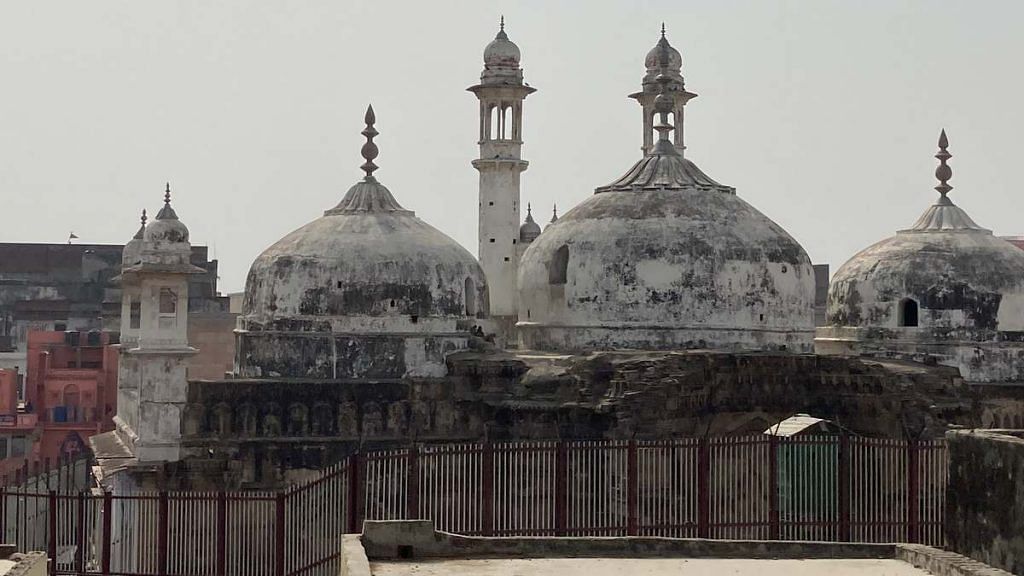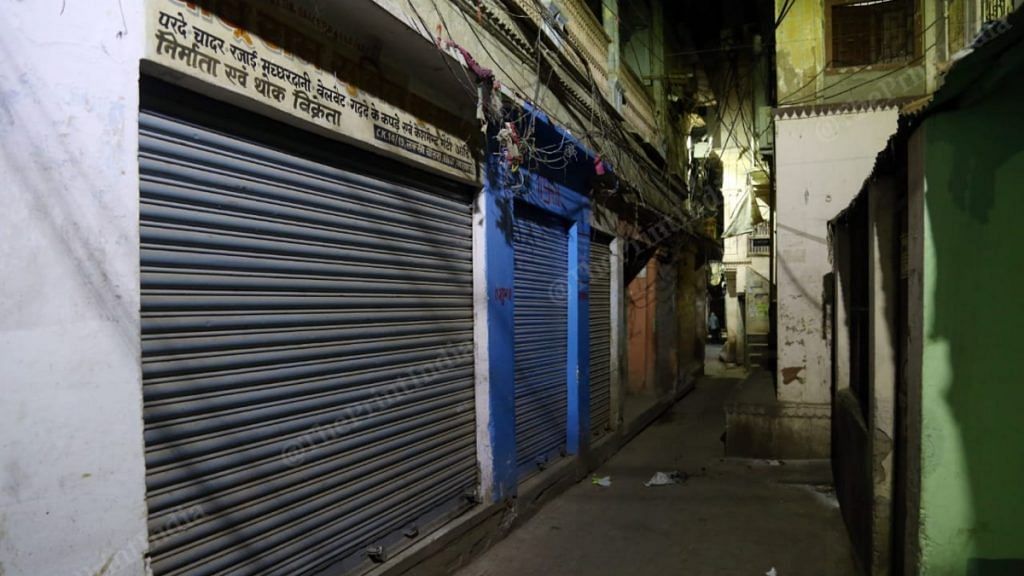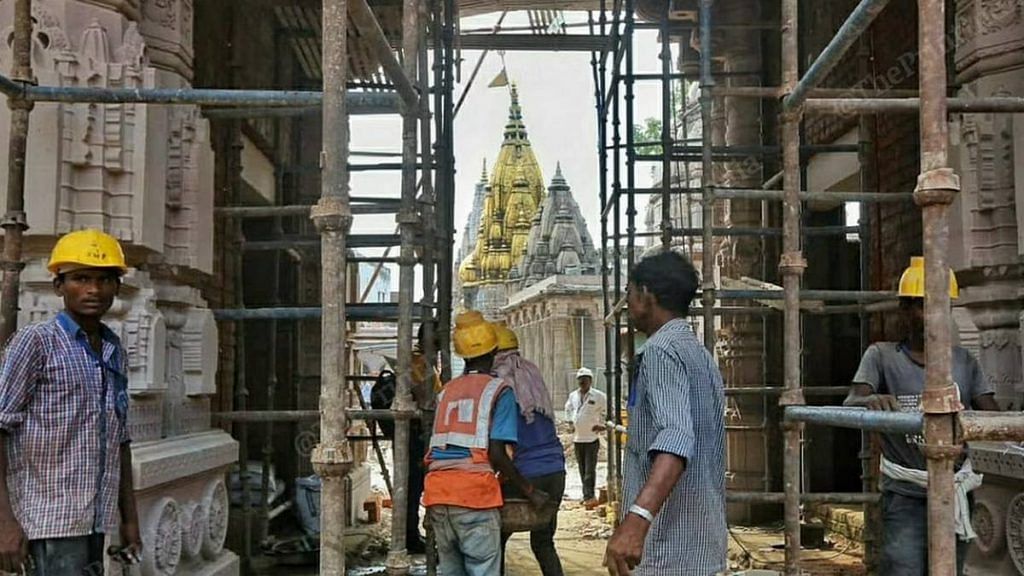Varanasi: The district court in Varanasi has become the site of a raging battle over historical narratives and ideology, but, for many residents of the ancient city, the dispute over the Gyanvapi mosque-Kashi Vishwanath temple complex has raised concerns about the future too.
“We used to play cricket in the Gyanvapi masjid compound and eat laddoos from the adjacent mandir. Today, politicians are making us fight over mandir-masjid,” Javed Akhtar, a 50-year-old mobile repair shop owner, told ThePrint.
“They are Hindu, we are Muslim, we eat together,” he added, putting his arm around Ballabh Das Aggarwal, a sari shop owner, who had joined him for a chat at a paan shop about 100 metres from the complex.
Nostalgia aside, 60-year-old Aggarwal is worried about his trade prospects. According to him, the revival of the dispute over the Gyanvapi mosque has been bad for business. “Tourists were coming in huge numbers before… so much so that we were earning well. That is why we don’t get into all of this debate,” Aggarwal said.
The “debate” in question is not a new one. In 1991, a lawsuit sought directions for the “temple land” of the Gyanvapi mosque compound to be handed over to the Hindu community, but the matter fizzled out.
The controversy was revived after a court-ordered survey of the mosque premises following a petition filed by a group of five women seeking permission to worship carvings of Hindu deities on the outer wall of the mosque.
The matter has, over the past few months, erupted into a major controversy. While there are claims that a purported Shivling (sacred representation of the Hindu god Shiva) was found inside the mosque premises, the Muslim side has vehemently disputed this.
The contentious issue, which has been compared to the Babri Masjid row, has exposed communal faultlines in Varanasi — the home constituency of Prime Minister Narendra Modi since 2014.

Known in the past as Banaras and Kashi, Varanasi is one of the oldest cities in the world, and, as might be expected, it has seen its share of bloodshed, starting with its near destruction in the 12th century by the warlord Qutbuddin Aibak, Muhammad Ghauri’s lieutenant.
Religious conversions followed soon after, as elucidated upon by chronicler Kubernath Sukul in his account Varanasi Vaibhav, considered to be one of the most vivid accounts on the city.
Since then, there have been other deep wounds: from Aurangzeb’s razing of temples in the 17th century to the Babri Masjid riots of 1991. Yet, in recent decades, there has been relative peace, with residents of different faiths giving precedence to their economic interdependence over ideological rifts.
“We can’t change history. We are also converted,” 65-year-old Waseem Khan ‘Baba’, a general store owner in Lahori Tola area, said.
It’s a sentiment many here share: they want peace so that they can do business and prosper, but many believe that politicians and the media will not rest until old scars are ripped open.
Also Read: Aibak, Akbar, Aurangzeb—the Gyanvapi divide & why a controversial mosque has a Sanskrit name
A history of communal conflicts, but not a ‘norm’
Over the past couple of centuries, Varanasi has witnessed several communal conflagrations, but these have been deviations from the norm rather than defining moments, say residents.
One of the first recorded communal clashes in the city took place in 1809, when the Shia mourning month of Muharram and the Hindu festival of Holi coincided. What is now called the ‘Lat Bhairon’ or ‘Lat Bhairava’ riot started when two large processions, one Hindu and one Muslim, found themselves on the same road and neither wanted to give way.
The historian and Indologist M.A. Sherring describes the incident in his 1864 book Benares, Past and Present: “They [Muslims] retired to the courtyard of Aurangzeb’s mosque, in which stood the highly venerated Lat [sacred pillar] of Shiva, and, combining together, threw it to the ground.”
Today, the vermillion-coloured Lat Bhairava, with the image of the deity encased in copper, stands on a platform in the middle of an idgah, a Muslim prayer ground. Hindus and Muslims both visit the site to offer prayers in line with their respective faiths.
The 1809 riot not the last time that a collision of religious processions led to violence.
Senior journalist Amitava Bhattacharya, who is considered an authority on Varanasi history and is a member of the managing committee of the Bengali Tola Inter College, recalled that one major riot in 1978 stemmed from Hindus tying to take out a Durga Puja procession from a predominantly Muslim area.
The late 1980s and early 1990s, when the Ram Janmabhoomi movement gathered steam and culminated in the demolition of the Babri Masjid, were also a time of communal churn for Varanasi.
In the aftermath of the shilanyas ceremony in 1989, in which the Vishva Hindu Parishad (VHP) laid the first stone of the Ram Temple, communal violence broke out across Uttar Pradesh, including in Varanasi.
In 1991, two days of communal violence left several dead when Hindu marchers shouted anti-Muslim slogans during a Kali Puja procession passing through the predominantly Muslim Madanpura area. Then, in 1992, Varanasi witnessed riots when religious violence engulfed India in the wake of the Babri Masjid demolition.
Since then, there have been some communal clashes reported from Varanasi, such as during the 2016 Lat Bhairava Baraat event, but no major riots.
More recent eruptions, according to Bhattacharya, have generally been “political” in nature and sparked by “outsiders”. The people of Varanasi, across communities, have largely striven for peaceful coexistence for practical as well as economic reasons.
Now, the dispute over the Gyanvapi mosque complex, which stands adjacent to the Kashi Vishwanath temple, is beginning to have ripple effects on business, local traders and workers told ThePrint.
Covid and inflation have already hit the economy hard, and communal tensions, many fear, could be the proverbial nail in the coffin.
‘Tourists are scared… have not seen such a slump’
Silk and spiritual tourism — these have traditionally been the two main pillars of Varanasi’s economy, and both have depended on communities working together.
In her book Crafting a Future: Stories of Indian Textiles and Sustainable Practices, textile designer Archana Shah writes of how “what is not possible to weave elsewhere in the country can be woven by the artisans of Benares”, with both Hindus and Muslims playing key roles.
While the majority of the weavers of the city’s famed brocaded Banarasi saris are Muslims, especially from the Momin-Ansari community, many of the zari (gold threads) and yarn suppliers are Hindus. The traders, too, belong overwhelmingly to Hindu Bania and Khatri communities.
After the lockdowns, everyone suffered, with sales of Banarasi saris reportedly plummeting by as much as 70 per cent.
Until recently, though, sales were beginning to pick up again. Tourism, too, was on an upswing due to Covid restrictions lifting, and people flocking to visit the Kashi-Vishwanath Corridor, which connects the temple to the River Ganga.
More tourists translated into a boost for hotels, restaurants, shops, and traditional businesses like silks and musical instruments.

But of late, the footfalls have been dwindling again, local residents told ThePrint, and Hindus and Muslims alike are suffering as a result.
“Tourists are scared… mediapersons have highlighted the [Gyanvapi mosque] issue so much. My shop is 122 years old but I’ve never seen such a big slump as in the past couple of weeks, even though it’s wedding season,” Ballabh Das Aggarwal, who is head of a traders’ body called the Chowk Gyanvapi Vyapar Mandal, said.
Akhtar (he did not want to reveal his last name), a sari shop owner in the Lahori Tola area, said the going was already tough, but now the situation was only worsening.
“Customers are not coming to the market. Their budget has been disturbed and people are scared. Before Eid [on 3 May], things were ok, but now, the market is badly affected,” he added. “Earnings are low while expense is too much. Eighty per cent of the market is down. We wanted to go to Delhi or Mumbai to attempt selling some saris but my parents advised against it saying that environment is not right.”
For weavers, who were already struggling to make ends meet, the situation seems even more dire. “Bekaar hai (it’s a waste),” one said when asked about the Gyanvapi dispute.
“We are unable to eat properly… why should we waste time by engaging in all this? The media should understand that we don’t want to talk about it,” Bablu, a 30-year-old sari weaver, said.
According to Akhtar, some weavers are selling their machines in desperation: “Some of my workers have managed to sell off their machines and are trying to take up other labour work. One worker asked me to purchase his machine but I made him understand that when I don’t have enough sales, what will I do with the machine?”
Even for labourers, work is hard to come by, shop owner Waseem Khan aka Baba said. “We are at least able to fill our stomachs. The poor labourers who earn Rs 300 a day are not getting work,” he pointed out.
“You can visit any of the labourer mandis and will find how 75 per cent of the people return without work. There are some 10-15 mandis in Bulanala, Maidaigin, Chetganj, Pandeypur, etc, where labourers are simply out of work,” Baba added.
‘Mandir-masjid bogey is being created by media’
Many ordinary residents in Varanasi believe that the ongoing dispute over the mosque is a distraction from “real” issues.
“Gas cylinder prices have gone up, inflation is at a high, there are floods in Assam… but is anyone talking about any of it?” Sheikh Salman, a 24-year-old student, said.
He had just emerged from the Gyanvapi mosque after offering prayers, but did not want to dwell on the controversy. “Hauwaa banaya ja raha hai (a bogey is being created),” he said.
Many here believe that the dispute has been given highly charged and undue coverage by a section of the media, which they say is trying to create tensions between communities.
“Godi media hai na… There are so many houses here that were broken (for the Kashi-Vishwanath Corridor construction). There were several temples in each house which were broken. People objected to this, but no one listened,” 35-year-old Shamshad Khan said.

According to him, it was irresponsible of the media to make a to-do about leaked reports of a survey of the contested site by court officials. These purported survey reports had outlined the presence of Hindu iconography and religious structures on the western wall and other portions of the Gyanvapi mosque premises.
“A Hindustan-Pakistan border has been created in Varanasi,” Aggarwal said, referring to the survey finding a purported Shivling in the wazukhana (ritual bathing area) of the mosque.
The media should instead show “the real thing”, Baba added — that the economy is floundering.
“We should be allowed to live peacefully. We are sitting idly throughout the day. Customers are not turning up. Earlier, we would attend to some 100-200 customers and, now, hardly two or three come. Local residents are not coming. The traders in Azamgarh, Jaunpur, Mau, Ghazipur are sitting inside idly,” he said.
Shariq Khan, who owns a construction business, also had a plea for the media. “Our country is very nice and our city is the best. Panditji goes to the temple and we go to the masjid. If the government really wants to do something good, it should lessen the media presence here,” he said.
‘Preparation for 2024?’
Varanasi voted definitively for the BJP in the Uttar Pradesh elections earlier this year, but many residents believe that divisive politics for votes by the party’s leaders could end up harming their city.
“It seems that the government is preparing for the 2024 general elections,” 65-year-old Shridhar Tripathi said.
“For one temple, you have created such a commotion. You have broken so many temples around here [due to the corridor construction]. Where did the idols go? They will not give any proof for that because they want to do their politics. You are making a Hindu-Muslim fight for politics, nobody is talking about whether people are getting to eat or not,” Tripathi added.
Shariq Khan, too, apportioned some blame to the BJP government for creating a rift among people. “Some people say that India has got freedom after 2014. This panchayat (debate) has begun only after that,” he said.
A student in her 20s, Farheen Khan, was visiting Baba’s shop. She said that she had earlier reposed hope in Prime Minister Narendra Modi but was now upset over the many controversies erupting over religion.
“They are now after the Taj Mahal also, and claiming there used to be a temple there… Have only Hindus voted for the BJP and Modiji? We, too, voted for him. And now, I am regretting it,” she said.
(Edited by Asavari Singh)
Also Read: A temple in the Taj Mahal? What Mughal-era documents tell us about tangled claims



